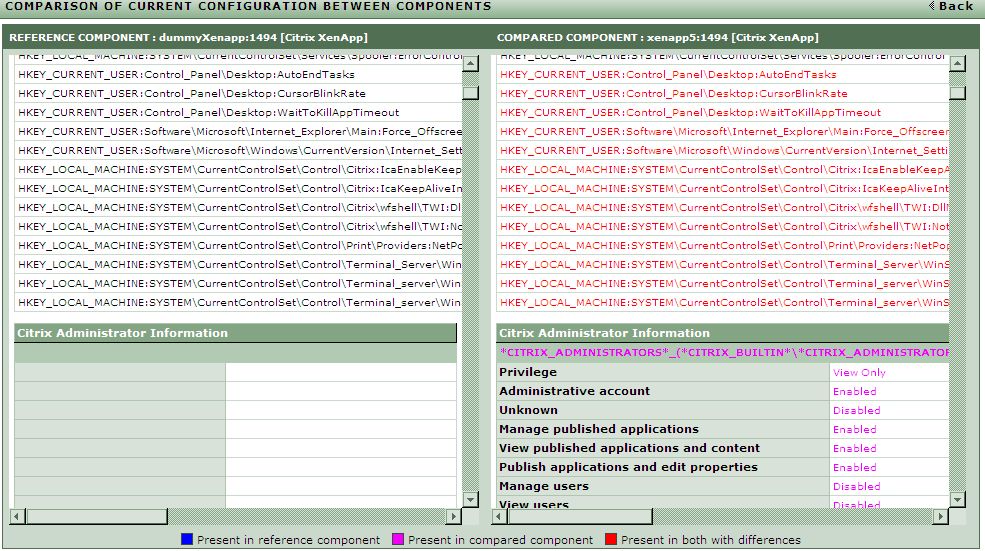Comparison
Comparison - By Component Type
Sometimes, in the real world, you will find that while one component of a particular type is performing well, sporadic/consistent slowdowns are observed in another component of the same type. Such discrepancies, may not always be owing to common factors such as an overload or a resource contention on the problem component; sometimes, even an improper configuration could lead to performance anomalies - for instance, if one component has been configured with a processor that is more powerful than that of another component, a difference in performance is bound to creep in. To diagnose the root cause of such performance issues, you should typically compare the configuration of the problem component with that of the healthy component. To facilitate such a comparison, the eG Configuration Management console provides the CONFIGURATION COMPARISON page. This page allows you to instantly compare the configuration of a component, typically a 'model' component, with that of other components of the same type so that, dissimilar components can be isolated, and the differences in configuration highlighted. This way, you can quickly get to the source of the performance problems experienced by a component.
This page can be accessed by clicking on the Comparison menu option.
To compare the configuration of components, do the following:
- Select a component type from the Component Type list box as depicted in Figure 1.
- All the configuration parameters that correspond to the chosen type will then populate the Information list box. To compare the value of a particular parameter across components, select that parameter alone from the Information list box; to compare the complete configuration of a component with that of the others, select all the options listed in the Information text box. By default, all options will be selected from this list box.
- Next, select a reference component from the Reference Component list box as depicted in Figure 1; the configuration of this component will be compared with that of one/more other components of the chosen type.
- All other components of the chosen type will then be listed in the Other Components list. From this list, pick the components to be compared with the reference component.
-
Then, click the SUBMIT button (see Figure 1).

Figure 1 : Selecting reference component to which it has to be compared
- This will invoke a table comprising of a SIMILAR COMPONENTS column and a DISSIMILAR COMPONENTS column. While the SIMILAR COMPONENTS column will display the list of components that are similar in configuration to the reference component, DISSIMILAR COMPONENTS column will display those components (of the chosen type) that are dissimilar to the reference component, in terms of configuration. Also, alongside each component in the DISSIMILAR COMPONENTS column, the number of differences noticed in configuration will also be indicated, within brackets.
-
Clicking on any component listed in the DISSIMILAR COMPONENTS column, will take you to the COMPARISON OF CURRENT CONFIGURATION BETWEEN COMPONENTS page as depicted in Figure 2.

Figure 2 : Comparing the current configuration between components
-
Using this page you can easily compare the values of each chosen Information between the reference component and the component clicked on. To enable you to accurately identify the discrepancies in configuration between the components in question, the following color coding is used across this module:
- Black: If the configuration parameters and their values are provided in the color Black, it denotes that no dissimilarities exist between the reference component and the other component.
- Blue: Values displayed in blue indicate those configuration entries that are available in the reference component, but not in the other component.
- Pink: Values displayed in pink indicate those configuration entries that are not available in the reference component, but exist in the other component.
- Red: Text in red are indicative of configuration parameters that exist in both the components, but the values of which have changed in one of the components.
Note:
You can also configure the tests/measures that you want to exclude from the purview of the comparison. For this, follow the steps given below:
- Edit the eg_configtests.ini file in the <eg_install_dir>\manager\config directory.
-
In the [exclude_test_measures] section of the file, you can configure entries of the following format to indicate which measures need to be excluded from the comparison:
TestName=<Comma-separated list of measures>
- Finally, save the file.
